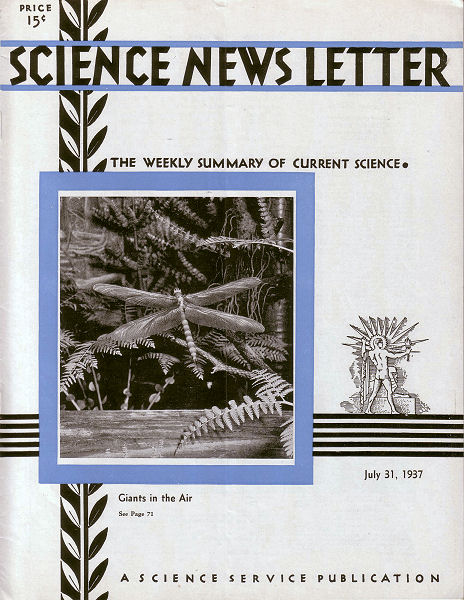From the July 31, 1937, issue

INSECTS WERE GIANTS WHEN COAL WAS IN THE MAKING
Giants were in the air, as well as in the earth, in the remote days when coal was in the making. Probably the most striking of them all was a genus of tremendous dragonflies, with a wingspread of about a foot, though their body diameter was not much greater than a lead pencil. The scene shown on the front cover of this issue of the Science News Letter is a detail from a restoration of a Coal Age forest, in the Field Museum of Natural History, Chicago.
HARVARD ASTRONOMERS DETECT COSMIC DUST CLOUD NEAR POLE
Confirming earlier scientific “suspicions,” Dr. Harlow Shapley, director of Harvard College Observatory, has just announced the discovery of a vast, sprawling cosmic-dust cloud near the north pole of the sky, obscuring and reddening the light from the stars in this area.
While such dust clouds in the sky have been found in the Milky Way, it is unusual to find one far removed. The new discovery will probably mean that the established values for magnitudes and the colors of stars in the polar region will need correction, said Dr. Shapley.
The polar dust cloud in space was found by studies of stellar photographs in a survey directed by Dr. Shapley and Miss Rebecca Jones.
The cloud region is about 2 astronomical degrees in diameter and removed some 3 degrees from the north pole of the sky.
Besides being irregular in outline, the cloud is also probably irregular in its blocking effect on the light from more-distant stars, the investigators believe. The presence of the cloud “leads one to suspect a lack of transparency throughout this region, where starlight is not only cut down in intensity but is affected differently for different wavelengths, with the result that star colors will be abnormal,” Dr. Shapley said.
IMPORTANT INVENTIONS LISTED AS HAVING SOCIAL INFLUENCE
Keep your eye on 13 very important inventions. These, in the opinion of the federal National Resources Committee’s Science Committee, “may soon be widely used with resultant social influences or significance.”
These inventions, as listed in a voluminous report just issued treating technologic trends and national policy, are:
- Mechanical cotton picker, which may displace millions of Southern cotton field workers.
- Air-conditioning equipment.
- Plastics, which are chemically made materials substituting for wood, steel, and other substances.
- Photoelectric cell, the “electric eye,” that can substitute for human routine operations.
- Artificial cotton and woolenlike fibers made from cellulose.
- Synthetic fiber.
- Prefabricated houses.
- Television.
- Facsimile transmission, by which pictures and messages are sent by wire and radio.
- Automobile trailers.
- Gasoline produced from coal, now commercially practiced in Europe.
- Steep-flight aircraft planes, such as autogyros and helicopters.
- Tray agriculture, or raising crops not upon soil but in tanks of nutrient solutions.
An immediate study of these inventions and their effects on our national economy is urgently recommended. This would be undertaken by experts in science, technology, economics, and other fields.







